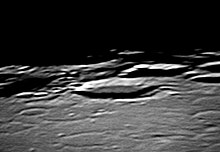Cleostratus (crater)
 Oblique Lunar Orbiter 4 image | |
| Coordinates | 60°24′N 77°00′W / 60.4°N 77.0°W |
|---|---|
| Diameter | 62 km |
| Depth | 2.2 km |
| Colongitude | 78° at sunrise |
| Eponym | Cleostratus |
Cleostratus is a lunar impact crater near the northwest limb of the Moon. It lies to the northeast of the crater Xenophanes, and west-southwest of the prominent Pythagoras. From the Earth this crater appears highly elongated due to foreshortening.
The rim of this crater has become soft-shouldered due to steady impact erosion, and the formation is now just a depression in the surface surrounded by an eroded rise. A pair of small craters lie across the southwest rim, forming part of a short chain of craters leading to the west. Along the crest of the southern rim is a linear ridge. The satellite crater Cleostratus E is attached to the northwest rim, and intrudes slightly into the inner wall. The interior floor of this crater is flat and nearly featureless, having only a few tiny craterlets marking the surface.

Satellite craters
By convention these features are identified on lunar maps by placing the letter on the side of the crater midpoint that is closest to Cleostratus.
| Cleostratus | Latitude | Longitude | Diameter |
|---|---|---|---|
| A | 62.7° N | 77.3° W | 35 km |
| E | 60.9° N | 79.6° W | 21 km |
| F | 61.5° N | 80.4° W | 50 km |
| H | 61.2° N | 81.9° W | 13 km |
| J | 61.3° N | 83.8° W | 20 km |
| K | 62.0° N | 81.1° W | 17 km |
| L | 62.2° N | 79.3° W | 11 km |
| M | 61.5° N | 74.9° W | 9 km |
| N | 60.6° N | 73.1° W | 4 km |
| P | 59.6° N | 72.9° W | 7 km |
| R | 58.9° N | 72.9° W | 6 km |
References
- Andersson, L. E.; Whitaker, E. A. (1982). NASA Catalogue of Lunar Nomenclature. NASA RP-1097.
{{cite book}}: Invalid|ref=harv(help) - Blue, Jennifer (July 25, 2007). "Gazetteer of Planetary Nomenclature". USGS. Retrieved 2007-08-05.
{{cite web}}: Invalid|ref=harv(help) - Bussey, B.; Spudis, P. (2004). The Clementine Atlas of the Moon. New York: Cambridge University Press. ISBN 978-0-521-81528-4.
{{cite book}}: Invalid|ref=harv(help) - Cocks, Elijah E.; Cocks, Josiah C. (1995). Who's Who on the Moon: A Biographical Dictionary of Lunar Nomenclature. Tudor Publishers. ISBN 978-0-936389-27-1.
{{cite book}}: Invalid|ref=harv(help) - McDowell, Jonathan (July 15, 2007). "Lunar Nomenclature". Jonathan's Space Report. Retrieved 2007-10-24.
{{cite web}}: Invalid|ref=harv(help) - Menzel, D. H.; Minnaert, M.; Levin, B.; Dollfus, A.; Bell, B. (1971). "Report on Lunar Nomenclature by the Working Group of Commission 17 of the IAU". Space Science Reviews. 12 (2): 136–186. Bibcode:1971SSRv...12..136M. doi:10.1007/BF00171763.
{{cite journal}}: Invalid|ref=harv(help) - Moore, Patrick (2001). On the Moon. Sterling Publishing Co. ISBN 978-0-304-35469-6.
{{cite book}}: Invalid|ref=harv(help) - Price, Fred W. (1988). The Moon Observer's Handbook. Cambridge University Press. ISBN 978-0-521-33500-3.
{{cite book}}: Invalid|ref=harv(help) - Rükl, Antonín (1990). Atlas of the Moon. Kalmbach Books. ISBN 978-0-913135-17-4.
{{cite book}}: Invalid|ref=harv(help) - Webb, Rev. T. W. (1962). Celestial Objects for Common Telescopes (6th revised ed.). Dover. ISBN 978-0-486-20917-3.
{{cite book}}: Invalid|ref=harv(help) - Whitaker, Ewen A. (1999). Mapping and Naming the Moon. Cambridge University Press. ISBN 978-0-521-62248-6.
{{cite book}}: Invalid|ref=harv(help) - Wlasuk, Peter T. (2000). Observing the Moon. Springer. ISBN 978-1-85233-193-1.
{{cite book}}: Invalid|ref=harv(help)

